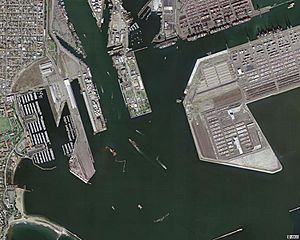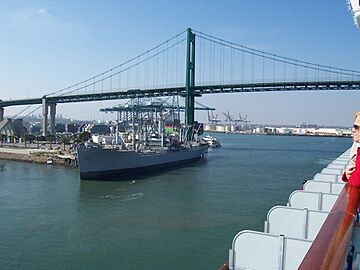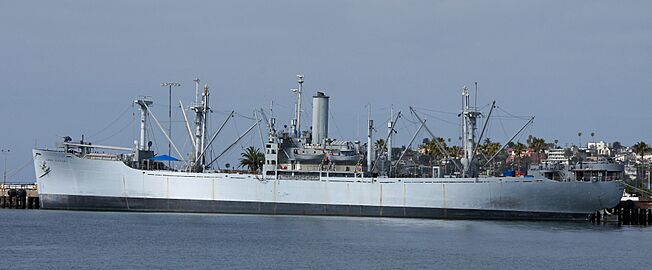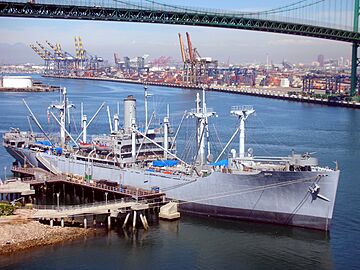SS Lane Victory facts for kids
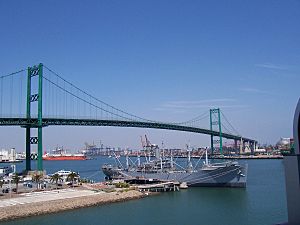
SS Lane Victory at its previous berth by the Vincent Thomas Bridge.
|
|
Quick facts for kids History |
|
|---|---|
| Name | SS Lane Victory |
| Namesake | Lane College |
| Builder | California Shipbuilding (Calship) |
| Launched | 1945 Los Angeles, California |
| Maiden voyage | June 27, 1945 |
| In service | 1945 |
| Homeport | San Pedro, California |
| Identification |
|
| Status | Museum Ship |
| General characteristics | |
| Class and type | VC2-S-AP2 Victory Ship |
| Tonnage | 10,750 long tons deadweight (DWT) |
| Length | 455 feet |
| Beam | 62 feet |
| Draft | 28 feet 6 inches |
| Propulsion |
|
| Speed | 17 knots |
| Range | 23,500 miles |
| Capacity | 500,000 cubic feet (approximate) |
| Complement | 62 United States Merchant Marine and United States Navy Armed Guard |
| Armament |
|
| Aircraft carried | none |
| Aviation facilities | none |
|
Lane Victory
|
|
| Location | Berth 52, Port of San Pedro, San Pedro, California |
| Built | 1945 |
| Architect | California Shipbuilding Corporation |
| NRHP reference No. | 90002222 |
| Significant dates | |
| Added to NRHP | 14 December 1990 |
| Designated NHL | 14 December 1990 |
The SS Lane Victory is a special American cargo ship. It's a Victory ship, which means it was built quickly to help during World War II. This ship also served in the Korean War and the Vietnam War. Today, it's a museum ship in San Pedro, California.
The Lane Victory is very important because it's one of the few Victory ships still around. Because of its history, it was named a U.S. National Historic Landmark. The ship got its name from Lane College, a school for Black youths started in 1882 in Jackson, Tennessee.
Contents
Serving in World War II
The Lane Victory was built in Los Angeles by the California Shipbuilding Corporation. It was launched on May 31, 1945, near the end of World War II. Its first trip began on June 27, 1945, carrying important war supplies across the Pacific Ocean.
The American President Lines managed the ship's operations. Brave Merchant Mariners sailed the ship. The United States Navy Armed Guard operated the ship's guns and handled communications.
The ship made two trips across the Pacific. One started on July 10, 1945, to Manus Island. The second began on August 30, 1945, heading to Guam, Saipan, and Hawaii. On the way to Guam, the ship delivered food to the island. It even sailed through a big typhoon for 14 days!
Its second voyage ended on February 27, 1946. After the war, the Lane Victory helped deliver aid. In March 1946, it started carrying goods to Europe as part of the Marshall Plan. This plan helped rebuild Europe after the war. Once the aid plan finished, the Lane Victory was put into storage on May 11, 1948, in Suisun Bay, California.
Heroic Actions in the Korean War
In 1950, the Lane Victory was brought out of storage to help again. By October 1950, it was back in service. It was sent to Wonsan, North Korea, to help evacuate Korean civilians and United Nations workers.
In December 1950, the ship became a hero during the Battle of Chosin Reservoir. It evacuated over 3,800 U.S. troops and 1,100 vehicles from Hungnam while under attack. The Lane Victory unloaded its cargo as other Navy ships provided covering fire.
After unloading, it took on 7,010 men, women, and children, carrying them south to safety. When the ship arrived, 7,011 passengers got off. A baby had been born during the journey! On October 10, 1953, the ship was put back into storage in Suisun Bay. Every year, a special day is held on the SS Lane Victory to honor those saved during the Korean War.
Supporting the Vietnam War
The Lane Victory was called back to duty one more time in 1966 for the Vietnam War. It helped move ammunition and supplies to and from the war zone. On April 29, 1970, the ship was laid up again in Suisun Bay. It joined the National Defense Reserve Fleet for storage.
During its time in three wars, the Lane Victory traveled all over the Far East Pacific. It also made several trips across the Atlantic Ocean and even sailed around the world once.
Saving a Historic Ship
Because the Lane Victory was kept in such good condition in storage, the Maritime Administration decided to save it. President Ronald Reagan signed a law on October 18, 1988. This law gave the ship to the United States Merchant Marine Veterans of World War II. A group of veterans, including Joe Vernick and John Smith, had worked for years to save the ship.
Volunteers from the Merchant Marine Veterans spent three years restoring the ship. It had been sitting in Suisun Bay for almost 20 years. Many updates were made to meet Coast Guard safety rules. In 1992, its hull was checked and found to be strong. On September 10, 1992, the ship had its sea trials and proved it was ready to sail again.
In May 1994, the Lane Victory sailed south along the Baja Peninsula. It planned to join another historic ship, the SS Jeremiah O'Brien, for the 50th Anniversary of D-Day in France. However, before reaching the Panama Canal, the Lane Victory had engine problems. This stopped it from crossing the Atlantic in time for the D-Day celebration.
In June 1994, the Lane Victory took part in a pretend Normandy invasion. This happened in the Santa Barbara Channel to celebrate the 50th anniversary of D-Day. In September 1994, it escorted the SS Jeremiah O'Brien from San Pedro to San Francisco. This was to celebrate the Jeremiah O'Brien's return from its trip to Normandy.
On October 9, 2007, the SS Lane Victory received a special award from the World Ship Trust. Today, it also serves as a training place for firefighters, police, the FBI, and the U.S. Coast Guard.
- Out of 534 Victory-class cargo ships built, only three are still working as museum ships. These are the SS Lane Victory in Los Angeles, the SS American Victory in Tampa, Florida, and the SS Red Oak Victory in Richmond, California.
A Special Museum Ship
After being acquired in 1988, the Lane Victory was moved to the Port of Los Angeles in San Pedro on June 12, 1989. It was then turned into a museum and a working ship again. In 1990, the Lane Victory was officially named a National Historic Landmark.
A team of dedicated volunteers takes care of and operates the ship. They also run its two museums on board. On September 13, 2000, Congress passed a resolution recognizing the SS Lane Victory. This honored the service and sacrifices of the U.S. Merchant Marine during times of war. The resolution stated that ships like the Lane Victory provided vital support by carrying equipment, supplies, and people for war efforts.
In February 2012, the ship moved from Berth 94 to Berth 46 in Los Angeles Harbor. It was reopened to the public on February 17, 2012. In early 2013, it moved again to Berth 49. This was because Berth 46 was being changed into a new dock for large cruise ships.
Lane Victory in Movies and TV
The Lane Victory has been used in many movies, TV shows, and commercials. This is because it is still in excellent working condition.
- The ship's wakes (the trails left behind a moving ship) were used in the 1997 movie Titanic. They were used for the wakes of the famous ocean liner.
- It was also the setting for the ending of the comedy film The Pest in the same year.
Other films where the ship appeared include:
- Black Ops (Deadwater) (2008)
- Flags of Our Fathers (2006)
- GI Jane (1997)
- Pearl Harbor (2001)
- The Thin Red Line (1998)
- U-571 (2000)
- Twin Sitters (1994)
The ship was also featured in the TV show Visiting... with Huell Howser (Episode 406).
Some TV shows that featured the Lane Victory are:
- Alias
- Baywatch
- California Gold
- JAG
- Mail Call (episode #70)
- MacGyver
- Murder She Wrote
- The National Geographic Channel
- NCIS
- Port Chicago Mutiny (TV movie)
- Return of the Pirates (History Channel)
- Special Ops Mission
- Unsolved Mysteries
In the King of the Hill episode "Returning Japanese: Part 2" (2002), a character named Cotton is sent back to the U.S. on the Lane Victory. The History Channel series Mail Call had an hour-long episode (6/04) all about the ship and the World War II Merchant Marine.
In 1999, the ship was used in a Ford Super Duty commercial and Disney's "Golden Dreams" commercial.
The engine displayed in the Lane Victory's front exhibit space was used as the engine for the fictional gunboat USS San Pablo in the movie The Sand Pebbles (1966).
Awards and Honors
The Lane Victory earned several awards for its service:
- One ribbon for its service in World War II.
- Two ribbons for its service in the Korean War: the United Nations Korea Medal and the Republic of Korea Presidential Unit Citation.
- One ribbon for its service in the Vietnam War.
Gallery
See also
- SS Meredith Victory
- SS American Victory
- SS Red Oak Victory
- World War II United States Merchant Navy





